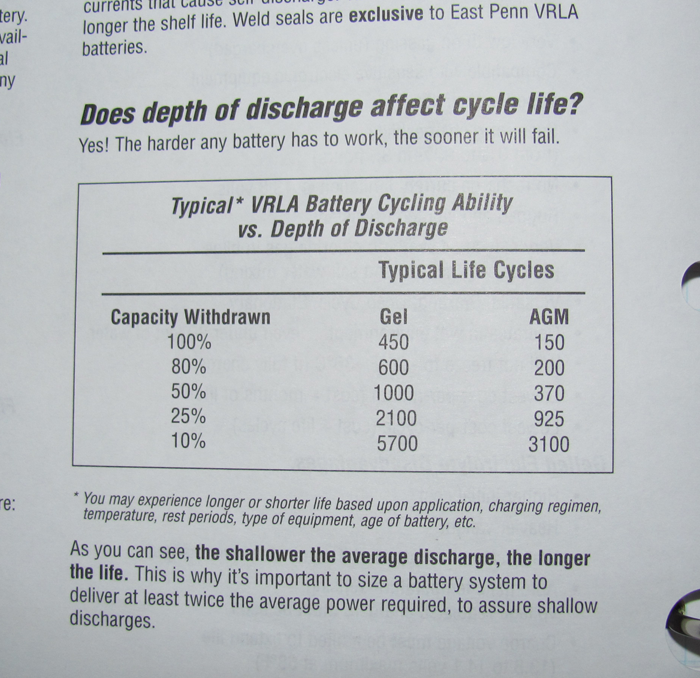Feel free to disagree with the harshness, but if one parrots what they read on the internet as fact without understanding the meaning .... then so be it

Great, you posted a cycle life versus DOD from East-Penn/Deka -- Let's see, 0.8 * 200 / 0.5 * 370 = 86.5% ... or you get 86.5% of the cycle energy at 80% DOD as you do at 50% DOD. Considering the posters goal is to have his carts on the road, not returning and charging all the time, then I think the 13.5% loss in total life will be quite acceptable. Now if the poster planned to keep the batteries in an extended state of discharge (which he does not appear to), that would be different, but it's not, so the 50% DOD is really rather meaningless.
By the way Poloman, the Eastpenn Deka AGM Deep Cycles are not that great of a battery. Lifeline (Concorde -- same as SunXtender) is a very good battery. Odyssey are very well rated, but often quite expensive and can actually be more finicky w.r.t. charging. Make sure you get the right one for purely deep cycle operation.
By that logic, you should never run LiFeP04 under 50% either, because it has much higher cycle life at lower DOD too.
WRCSixEight, I can't agree with your statement (or method either necessarily). There are good chargers out there. The higher end CTEK's run a proper and full charge cycle with a proper bulk and absorption charge and a proper current based end of charge. They also, and this is very important, have temperature compensation, which is needed if you are charging in a non-temperature controlled environment, especially if charging in cool temperatures.
In terms of Burgerman, the fact he charges at <0.2C in many of his "tests" shows his lack of understanding of proper cycling charging of an AGM battery. At least he uses a 7A CTEK, but if he was serious, he would not have waited so long to get a 20A Universal hobby charger ... which still does not do temp compensation, essentially if your "vehicle" is left outside. It can take 3+ hours for the internal temp to reach ambient temperature if not longer .... and I have actually designed\built multi-stage microprocessor controlled lead-acid charge controllers with temperature compensation, temp ramp compensation, data logging, etc.
New York City .... are these used year round or only "nicer" weather. LiFeP04, the affordable ones, don't like <0C very much under heavy discharge. You can lose a ton of capacity, more than AGM. The rest of the year, you will appreciate the lower weight. 24V, 100AH you will not find, but you can find Group27 (same as AGM), 12V, 100AH. TopBand (China) makes a tolerable one. I know in China, they are about $550 USD in low (i.e. 10) quantity. You of course need to get them to your place. I am not sure who stocks in the U.S. There are other form factors for 12V, 100AH that may be suitable but likely more money. BYD F12100 is about $850 .... good battery though.
Semiman


